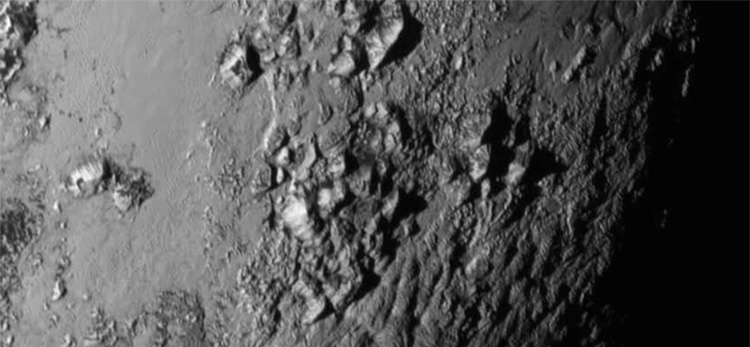The world waited in anticipation just a week ago when the first high-resolution images of Pluto and its moons were released by NASA—the first detailed look at what was once our furthest sibling in the solar system.
Geographers in particular gazed in wonder at the dwarf planet’s vast ice mountains and smooth plains, but they looked at the photographs in a fundamentally different way than most people. What they saw was the story of Pluto.
Dr. Joseph Garcia, a physical geographer and professor at Longwood University in Virginia, was one of the scientists who eagerly awaited the photographs. "Anyone can look at a photograph or a topographical feature through what is generally referred to as the ‘geographic approach,’ he said. "Geographers examine spatial patterns—how features of interest are locationally organized, distributed and connected, and offer explanations for what they observe. The geographic approach is a problem solving methodology that can be helpful in understanding the ‘how’ and the ‘why’ of processes responsible for these features."
It’s the story of the formation of Pluto and our solar system that scientists hope these photos can reveal—much as the story of Earth has been revealed by what we have observed over the last several centuries.
Ice mountains

In the mid-18th century, Scottish geologist James Hutton coined the phrase "uniformitarianism," which modernized the way geologists and geographers view the world—in short, that the physical processes of the world have, for the most part, always operated as they do today. The key to the past lies in the present. The current consensus is that Earth’s geologic features were created by slow, gradual processes largely controlled by the gradual but persistent movement of land masses, known as ‘lithospheric plates,’ moving across the earth’s surface.
When geographers look at Pluto’s ice mountains, they see a similar story.
"When geographers look at foreign worlds, we apply terrestrial analogs to extraterrestrial features," said Garcia. When we consider mountainous features on planets, we typically consider two basic ways a mountain can be created: a ‘top-down’ or external set of processes whereby different minerals and rocks near or just below the planet's surface react to erosional forces in different ways, and a mountain is revealed as the surface is stripped away, or a ‘bottom-up’ or internal group of forces within the planet causes uplift and mountain building."
Seeing mountains as the end result of a long process of change is a trademark of the geographic approach, and, using this approach in viewing the photos of Pluto, the dwarf planet starts to come alive in a sense. And testing theories about the way its enormous ice mountains are formed can give us some sense of the story of the early solar system.
Pluto’s Old Faithful?
One of the most confusing features NASA scientists mentioned in their initial press conferences was the existence of dark streaks that were reminiscent of geysers on the icy surface of Pluto. While it is confusing to many observers, geographers see it as another puzzle piece in the story of the distant sphere.
"Again, we apply terrestrial analogs to what look like geysers on Pluto," said Garcia. "That opens up the possibility that there is an active and dynamic interior within this planet that may have convective cells somewhat similar to Earth’s mantle. It seems like Pluto is or has been quite active—not just a ball of ice that’s flying around the sun—and that’s quite exciting."
Garcia cautions, however, about only applying our knowledge of how the Earth operates to a place as foreign as Pluto. "We have an understanding of how geysers work here on Earth," he said, "but that shouldn’t limit us from exploring options that haven’t been dreamed up yet. With new territory to explore and much more data to gather, geographers have trained themselves to be open to extraordinary new possibilities—which may, in fact, reveal the answers to questions we still have about our own planet."
Smooth ice plains
Sitting next to the huge mountain ranges of Pluto are vast, smooth ice plains—similar to photographs of Antarctica’s ice plateaus. NASA scientists have said they suspect this ice surfaced within the last 100 million years—a blip in the history of Pluto—and maybe even as recently as last week.
"A geographer is trained in the art of deduction," said Garcia. "This is very much like CSI or any other forensic investigation—we are gathering spatial evidence from observations and making informed conclusions about planet-shaping events that may have happened in the past and may possibly still be active. These smooth plains next to mountains are another clue that Pluto is a geologically complex planet."
On the plains are polygonal features that look strangely like mud cracks in drought-stricken California. These could come, said Garcia, from some kind of conductive heat from deep inside the planet, dehydration of surface minerals, or a process that we haven’t yet discovered. "We know that the atmosphere on Pluto is extremely thin," he said, "so geographers have to expand our understanding to the possibilities of several land-shaping processes at play in this type of environment."
The data and photographs coming into NASA headquarters are fresh, and it will take more than a year to collect all the information discovered by the New Horizons probe. But, just a month ago, Pluto was a pixelated dot. With these new photographs, the story of Pluto is coming into focus.



Leave a Comment